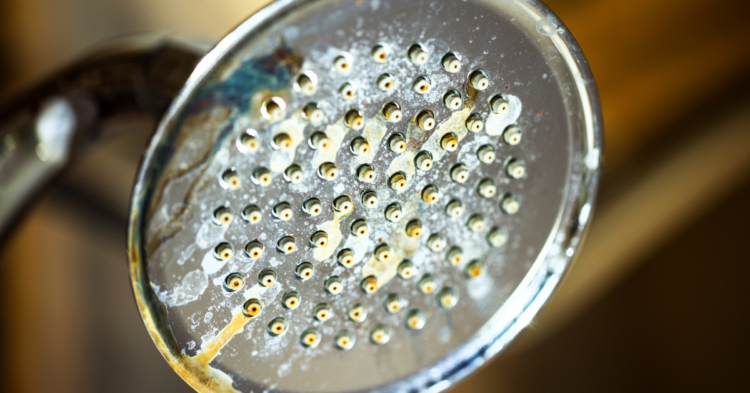Water that Stains
Help! My hair is orange, my coffee is purple, my white clothes are ruined, and I have red stains in my sinks and toilets!
Water Stains Red –
Red or orange water is most often caused by iron (rust) in the water. Testing is needed to determine the amount and the type of iron you have. Iron in water may be: ferrous or ferric. As little as 0.3 parts per million can turn your white clothes yellow/brown and leave a reddish/brown stain in your toilets, tub, shower and sinks. When your water is “hard”; iron stains can be even worse.
Common treatments for iron are: Ion exchange water conditioners and softeners, oxidizing filters, chemical oxidation with filtration, and aeration with filtration.
Ferrous Iron – Water containing ferrous iron may be clear and colorless because the iron is completely dissolved. Ferrous iron is sometimes referred to as “clear water” iron. With this type of iron; water appears clear at first but develops black or rust colored particles that settle out when allowed to stand undisturbed. These particles develop when the ferrous iron reacts with air, chlorine, or other oxidants to form ferric iron (rust). When the iron concentration is less than 5 parts per million you may solve this problem with a Water Conditioner.
Important note: Some conditioners are far more efficient and effective than others. When the iron concentration is heavy (generally; over 5 p.p.m.) an Iron Oxidizing Filter coupled with a Water Conditioner may be needed. In the worst case scenario (over 15 p.p.m. iron) the Iron Oxidizing Filter may need to be supported by a Chlorinator, Ozone System, or an Aeration System to oxidize the iron and enhance the removal rate.
Note: Chlorine from the chlorinator is removed by a carbon filter in the final stages of the system (You don’t want to drink or bathe in, chlorinated water as it is very unhealthy!)
Ferric Iron – often called “red water” iron is insoluble in water. When the water appears “rusty” or has a red or yellow color, it is ferric iron. It is recognized by the red-brown or black particles when first drawn from the tap. Often the most effective method for removing this type of iron is with a Backwashing Iron Filter. A cartridge type filter is most often, Not a good solution because ferric iron may plug the element too quickly and you’ll expend a great deal of extra money on replacement filter cartridges.
The other method or removal is by feeding a chemical (Chlorine or Ozone) into the water to cause the particles of iron to clump together making them easier to remove. A Chlorinator or other “oxygenator” is often installed before the Backwashing Iron Filter for this purpose.
Iron Bacteria – are living organisms that feed on iron in water, iron pipes and fittings, etc. They deposit “slime” inside pipes & fittings as well as in your sinks, toilets, shower, bathtub and hot water heater. Occasionally, a slimy growth breaks free to cause discolored water and can, on rare occasions, clog your water system or pump.
This type of iron problem can be very challenging to eliminate. The bacteria must be killed. A disinfection process is required. The most common treatment is Chlorination. A high concentration of chlorine throughout your plumbing system is needed. In those worse case scenarios; it may be necessary to feed chlorine continuously to prevent re-growth. Remember; a Carbon Filter or filters, placed after the Chlorinator will remove the chlorine.
Water Stains Blue or Green Stains on your Fixtures?
The challenge here is either the element copper in your water supply or you have copper pipes and corrosive (acid pH) water.
Copper Pipes and Corrosive (Acid pH) Water – When the pH of your water is between 5 and 7 you may raise the pH by passing the water through a Calcite “Filter”. By sacrificing calcium carbonate into the water; the pH will be increased and the corrosion will be reduced or halted. If the pH is below 5, in order to raise the pH, chemicals are needed.
The element; Copper – can often be removed by a Water Conditioner.
Excess oxygen – If the corrosion is caused by excess oxygen, your hot water will be more corrosive than the cold. Excess oxygen is treated by feeding polyphosphate or silicates into the system to coat and protect the plumbing, or by aerating the water to release the excess oxygen.
Determine the source: If you have a staining challenge, a logical first step would be to determine the source. As mentioned above: the source of stain may be from the corrosion of water pipes within your home, from soils and rocks, or from the city water distribution system. You may be able to accomplish this yourself. If not, an in-home visit by a well-trained water treatment consultant or water treatment specialist may be needed. **Having your water tested will provide clues to the source of the stain and much more information.
Test your water: A laboratory analysis of your water to determine the extent of the problem and possible treatment solutions should begin with tests for iron concentration, iron bacteria, pH, alkalinity, and hardness. If the stains are blue-green in color be sure to mention this to the lab tech who receives your water sample.
Helpful Links and References for Water that Stains:
- Pumice Stones to easily clean your toilets without scratching it (and not harming your septic system): https://youtu.be/14dULhTDh6s
- Cleaning toilets with RingX: https://youtu.be/rKuAaeQ0FwU

